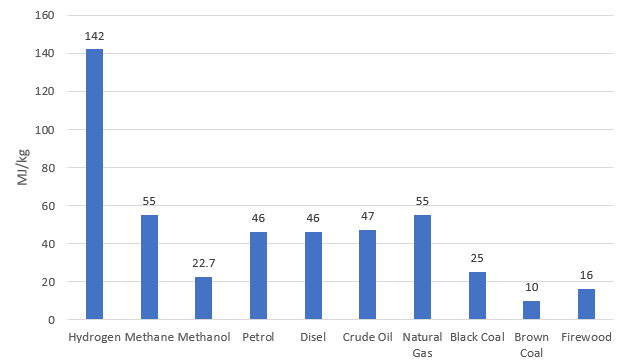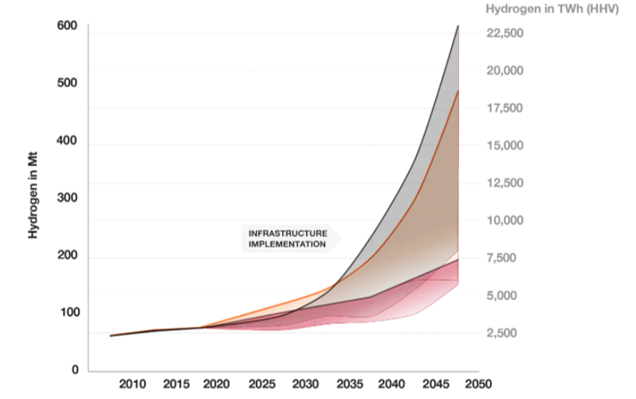For those trying to understand what the future opportunities are in the Hydrogen market, the following is an excellent summary from Max Pacella from Mason Stevens. Grab a copy a coffee and have a read.Current Hydrogen Market
The current demand for hydrogen is almost exclusively within the industrial refining and agricultural sectors.
According to research house MarketsandMarkets, the global hydrogen market was worth approximately $130 billion USD in 2020, with a projected growth rate of 9.2% per annum out to 2025. This would place the market at approximately $200 billion USD.
Around 95% of the hydrogen produced in the world is known as “grey hydrogen”, which uses a method known as “steam methane reforming”, using either natural gas or coal seam gas. This is a dirty, but cheap process which produces on average 10kg of carbon dioxide per kilogram of H2 (source: CEFC). This has resulted in approximately 830 million tonnes of carbon dioxide per year at current production rates.
For this reason, hydrogen is mostly used by dirty industries today, at least at scale. As of 2018, 51.6% of global hydrogen demand went to the chemical processes used in petroleum refining, and 42.5% went to ammonia production for fertiliser (source: IEA). On the fringe sat “niche applications”, such as the development of hydrogen fuel cells.Looking only at the commercial-scale figures at the moment, you may be forgiven for assuming that hydrogen was doomed to forever be a dirty, relatively small industry.
But that is not the case and – appropriately enough for a potential fuel source – there are catalysts waiting just over the horizon to completely transform how we view hydrogen in the coming decades.
The Future of the First Element
From a structural point of view, there is an increasing demand for energy production and long-term storage – the entire world is not yet industrialised, and beyond that, the entire world is certainly not employing the most efficient methods of power generation.
Consider for a moment the below heat values of various fuels – this is the amount of heat released during its combustion, a highly important statistic when considering the merit of a fuel source.
Chart 1: Heat Value of Fuel Sources
Source: Mason Stevens, World Nuclear Association
Looking at these figures alone, it’s a no-brainer that hydrogen should form a much larger part of our global energy mix. However, the explosive nature of the gas, as well as the carbon-intensive nature of current production, have limited this prospect.As an aside, interesting to see that firewood has a higher heat value than brown coal.
Enter green hydrogen, produced using renewable energy (currently proposed to be solar and wind) to power electrolysis – the chemical process for splitting the oxygen and hydrogen atoms apart in water using electric currents.
Whilst in European markets (currently some of the most developed for hydrogen), “grey” hydrogen costs around £1-2/kg, green hydrogen currently costs anywhere from £3-8 /kg, making the economics challenging. The main barrier to lowering costs is access to low-cost renewable energy, so green hydrogen is in a symbiotic relationship with the global push towards renewables.
According to a recent study by PwC, Australia, the US and the Middle East have lower potential costs of production for green hydrogen due to our higher volume of low-cost renewables (around £3-5/kg).
Their chart on the demand for global hydrogen by 2050 is a fantastic illustration of two dynamics at play; the ability to develop and implement sufficient infrastructure to make hydrogen applications viable, and how seriously we take temperature targets.
The grey line is driven by keeping a global temperature rise below 1.8 degrees Celsius, orange between 1.8-2.3 degrees, and red above 2.3 degrees.
Chart 2: Forecast Global Hydrogen Market Demand
Source: PWC
We will touch on some potential use cases in a moment, but it is likely that there will be one key catalyst to accelerate the investment thesis for the new hydrogen economy: policy support.
There are some existing initiatives already in place, however a global effort towards decarbonisation will be the ultimate driver of developing the technology and infrastructure needed to unlock hydrogen’s true potential.
- The U.S Secretary for Energy came out earlier this year to commit to the Hydrogen Earthshot program, with the goal of green hydrogen at a cost of $1/kg USD by 2030
- This follows a $33 million USD funding plan to support hydrogen fuel cell R&D proposed in December 2020
- In Q1 2021, the EU proposed to establish a Clean Hydrogen Partnership, under which the EU would provide £10 billion of funding, which industry partners would also match, to further the production, distribution and storage of green hydrogen
- South Korea finalised their carbon neutrality roadmap last week, proposing for 97% of their vehicles to be powered by hydrogen-fuel cells or lithium-ion batteries by 2050
- Ineos, a major UK chemicals company, announced plans to invest $2.3 billion USD in green hydrogen production across Europe between now and 2030
- Hydrogen fuel cell development is anticipated to be part of China’s recent 2021-25 Five Year Plan goals, as part of the “future industries” targets
The wheels appear to be in motion to begin building out our hydrogen capabilities, and the breadth of policies/initiatives across the globe is encouraging to see, as scale can be achieved from multiple policy regimes simultaneously.
As we develop our green energy infrastructure, the use cases for hydrogen balloon out far in excess of only dirty industrial applications:
- As hydrogen fuel cell technology continues to improve (both in stability and capacity), it will be more viable for hydrogen refuelling stations to be created to fuel heavy transport and commercial cars with this eco-friendly gas.
- From the heat value graph above, the potential for energy production is clear. Hydrogen currently represents a compelling option for a renewable energy source which can be stored – being kept in reservoirs to be used on demand rather than waiting for the wind or the sun for power. Hydrogen mixed with ammonia is currently the leading strategy, which can be used in gas turbines and be a supplement to our existing power infrastructure as we seek a baseload source to replace coal-fired power stations.
- Green hydrogen can be integrated into existing industrial processes, further enabling the push towards green agriculture and green steel. This is particularly relevant as costs of production decrease below even that of grey hydrogen – potentially having deflationary impacts on these industries in the long run.
- In city infrastructure, hydrogen gas can be connected to existing natural gas infrastructure to provide gas to homes, commercial buildings and industrial complexes, which is not even touching on the potential for industrial-scale hydrogen fuel cells to provide power sources to buildings.
The end result would be a more flexible power grid, operating at a lower cost, with a fuel source which has a higher energy capacity and is more on-demand than our current renewable profile.
- Forums
- ASX - By Stock
- Video: ADX signs MOA with Renewable Power Provider for H2 Project
For those trying to understand what the future opportunities are...
- There are more pages in this discussion • 2 more messages in this thread...
You’re viewing a single post only. To view the entire thread just sign in or Join Now (FREE)
Featured News
Add ADX (ASX) to my watchlist
 (20min delay) (20min delay)
|
|||||
|
Last
11.5¢ |
Change
-0.005(4.17%) |
Mkt cap ! $50.46M | |||
| Open | High | Low | Value | Volume |
| 12.5¢ | 12.5¢ | 11.5¢ | $33.80K | 282.3K |
Buyers (Bids)
| No. | Vol. | Price($) |
|---|---|---|
| 14 | 833213 | 11.5¢ |
Sellers (Offers)
| Price($) | Vol. | No. |
|---|---|---|
| 12.5¢ | 91500 | 2 |
View Market Depth
| No. | Vol. | Price($) |
|---|---|---|
| 14 | 833213 | 0.115 |
| 10 | 754922 | 0.110 |
| 14 | 537976 | 0.105 |
| 4 | 280000 | 0.100 |
| 1 | 30935 | 0.097 |
| Price($) | Vol. | No. |
|---|---|---|
| 0.125 | 91500 | 2 |
| 0.130 | 540877 | 9 |
| 0.135 | 47000 | 2 |
| 0.140 | 75284 | 2 |
| 0.145 | 44100 | 2 |
| Last trade - 16.10pm 19/04/2024 (20 minute delay) ? |

|
|||||
|
Last
12.0¢ |
Change
-0.005 ( 0.00 %) |
||||
| Open | High | Low | Volume | ||
| 12.5¢ | 12.5¢ | 12.0¢ | 218500 | ||
| Last updated 14.57pm 19/04/2024 ? | |||||
Featured News
| ADX (ASX) Chart |








